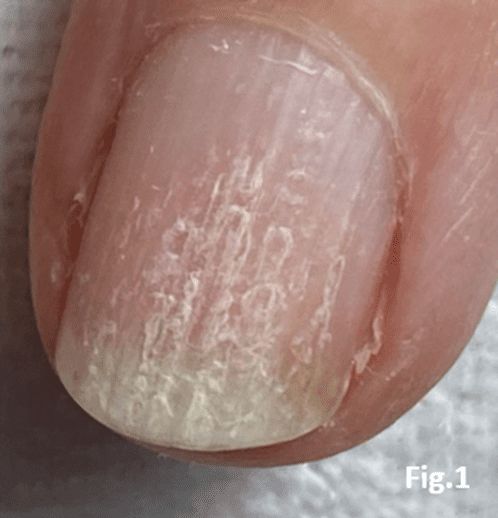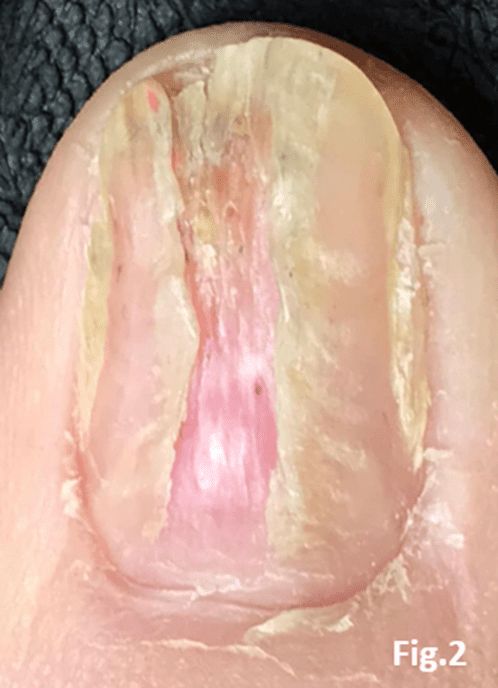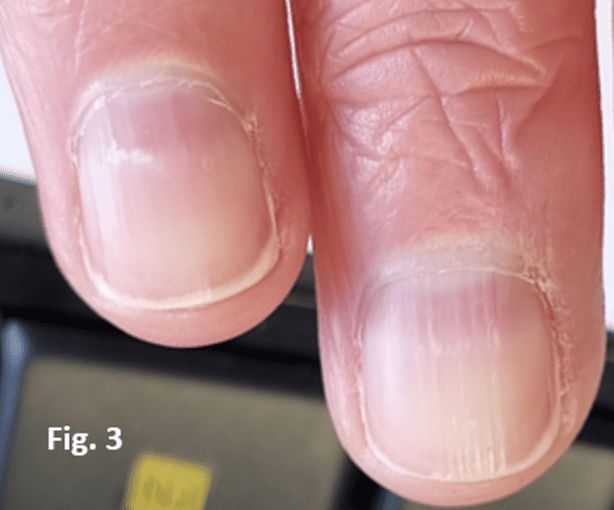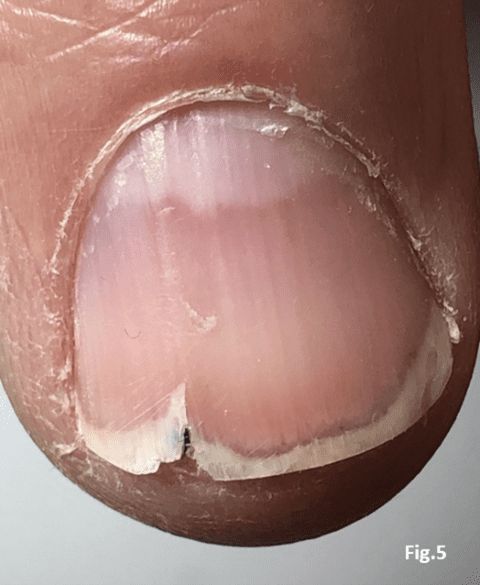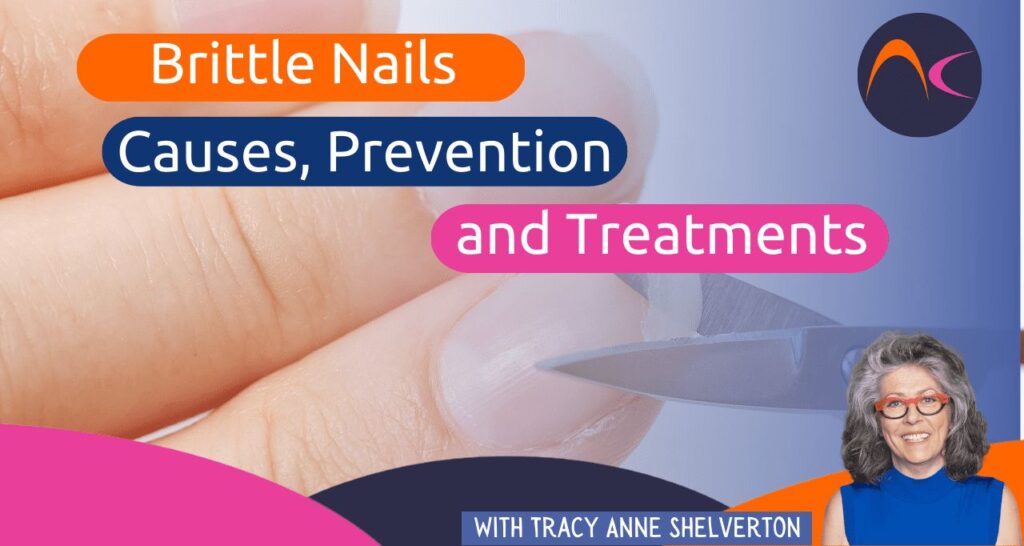Brittle nails are a common problem that can affect anyone. If you’re dealing with nails that constantly split, peel, or break easily, you may be wondering what’s causing this issue and how you can fix it. In this article, we’ll explore the causes, prevention, and treatment options for brittle nails.
Causes of Brittle Nails:
There are many reasons why someone might develop brittle nails. Here are some of the most common causes:
- Dehydration:
- is the #1 cause of brittle nails – Oil and lotion for our skin & nails will help replenish the moisture and oil we lose in our regular daily lives.
2. Nutrient Deficiencies: Brittle nails can be a sign of nutrient deficiencies, particularly in vitamins and minerals such as biotin, vitamin E and vitamin C.
- A good balanced diet can help. The nail matrix produces nail plate cells 24/7 it gets its nutrients from our blood.
We have 20 different nail matrix’ for 20 different nail plates, it’s possible that one or more of these has a restricted blood supply or that it is damaged in some way. Just because one nail unit is affected does not mean that all of them are, but all of them can be affected.
3. Harsh Chemicals: Excessive exposure to harsh chemicals like cleaning agents, but the one solvent that can really cause the problems is water.
- We don’t think of water as dangerous. The nail plate is made up of a complex composition of nail plate cells that are bound together with compounds that create the perfect flexible nail plate. When the nail is filled with water (that happens in a very short time) it becomes softer & expands (you might find that trimming your toenails is easier after a bath or sauna). When the water evaporates the nail plate cells shrink and become hard again, this movement causes tiny fractures and splits in the nail to become larger and the nail becomes even more prone to splitting.
4. Aging: As we age, our nails tend to become more brittle and drier.
- If the nail plate is split, even just slightly, its structure is compromised, and it will start to lose its ability to maintain its moisture balance and be prone to more splitting and possible pathogen infections, even from our own resident microbiome.
5. Medical Conditions: Certain medical conditions like hypothyroidism, alopecia, lichen planus, eczema or psoriasis can cause brittle nails.
- This is because all of these conditions affect the production of nail plate cells in some shape or form when the nail matrix is involved.
6. Lifestyle Factors: Habits like biting nails & poor diet
- We have 20 different nail matrix’ for 20 different nail plates, it’s possible that one or more of these has a restricted blood supply or that it is damaged in some way. Just because one nail unit is affected does not mean that all of them are, but all of them can be affected.
Fortifying Your Nails: Strategies for Enhanced Strength and Resilience
Fortunately, there are ways to prevent brittle nails from occurring in the first place. Here are some tips:
- Practice Good Nail Hygiene and Maintenance: Keeping your nails clean and dry can help prevent fungal infections and other issues that can weaken the nails, applying oil regularly will help your nails maintain flexibility.
- Infections can break open the nail plate and cause excessive dryness that will contribute to brittle nails.
2. Avoid Harsh Chemicals: Minimize your exposure to harsh chemicals and wear gloves when working with cleaning agents or other chemicals.
- Water, although safe, is a chemical – and one that can affect our nails instantly. (see point 2 above under the cause of brittleness)
3. Eat a Healthy Diet: A balanced diet rich in vitamins and minerals can help strengthen your nails from the inside out.
- Anno 2023 we know that the only way to influence nail plate production is via the nail matrix and the matrix depends on a blood supply to receive its nutrients.
4. Use Protective Coatings: Protective coatings can help add a layer of protection to your nails.
- When we apply a nail coating to a natural nail it can help the nail to ‘feel’ stronger, but the nail will only be as strong as the coating, but beware … We assume that the harder the coating the stronger the nail – but its not the case, the nail underneath the coating is as weak or brittle as it ever was.
- Oil and Lotion in nail maintenance is essential to stop brittleness and create flexibility in the nail supporting the nail coating.
- Your professional nail salon will choose the right nail coating for you, it could be that a flexible coating with good nail maintenance will solve your problem but it could be you need a professional strengthener or an overlay of acrylic or acrygel to help.
5. A professional salon treatment adds strength but does not compromise on flexibility.
- Using a professional product that can penetrate the upper layers of the nail, sealing them while maintaining flexibility or even improving flexibility is a good way to help your nails become less brittle.
Treatment of Brittle Nails
If you’re already dealing with brittle nails, there are several treatments that can help:
- Topical Oil & Lotion: Certain creams containing urea, allantoïne, alpha-hydroxy acids, or lactic acid can help moisturize and strengthen the nails as well as good quality nail oil.
- Nail Polish: Applying nail polish or a flexible nail coating can help seal in moisture and add a protective layer to your nails.
- Use professional nail strengthening treatment applied in your salon and trust your salon to choose the best nail coating option for your nails.
- Keep your nails and hands clean and after washing replenish the moisture and oils that have been washed away.
Weak Nails: Tackling the Challenge of Fragility and Disrepair
However, don’t despair as they are often preventable and treatable.
By following good nail maintenance with oil & lotion, good nail hygiene practices, eating a healthy diet, and protecting your nails from harsh chemicals, avoiding excessive water exposure, you can keep your nails strong and healthy.
If you’re already dealing with brittle nails, don’t hesitate to try one of the treatment options available to you.
Be sure to read our article on the benefits of cutical / nail oil
Brittle Nails can be all shapes and sizes
There is not one picture to show what a brittle nail is, so we need to define it.
Brittle means ‘Hard but liable to break easily.’
‘Brittle’ describes a condition, but there are many nail conditions that can be described as brittle. Any break in the defences or malfunction in the creation of our nail plates can cause them to become brittle.
- Figure 1: Beaded Ridge Nail Plate – A beaded ridge nail plate, the upper layer is brittle.
- Figure 2: Lichen Planus Nail Plate – A Nail Plate that is affected by Lichen Planus is also brittle.
- Figure 3: Vertical Groves – Verticle Groves splitting in the Nail Plate cause the nail plate to become brittle.
- Figure 4: Onychoschizis – This is a special kind of delamination called ‘Onychoschizis’. Onychoschizis causes the loose nail plate to become brittle.
- Figure 5: Verticle Split – The vertical split in this nail plate has caused it to become brittle where the groove meets the ridge.
